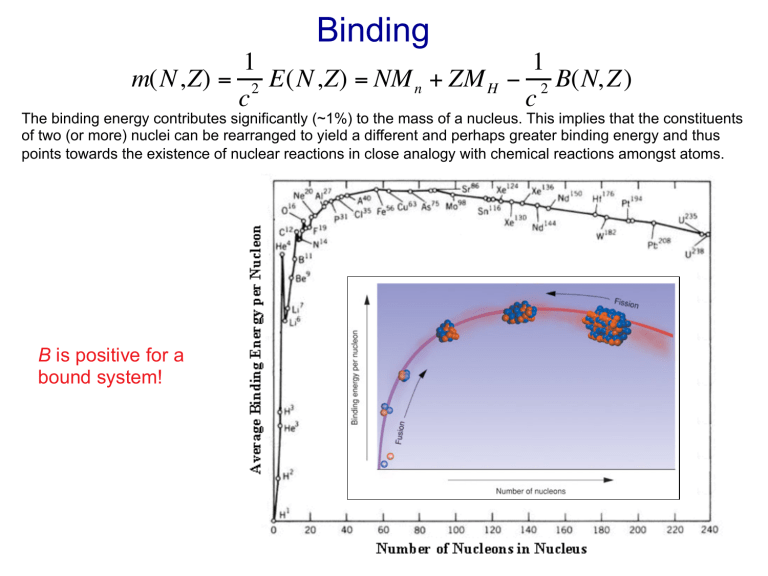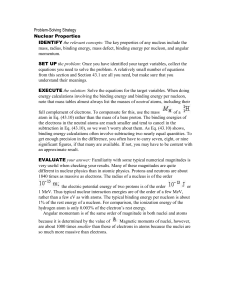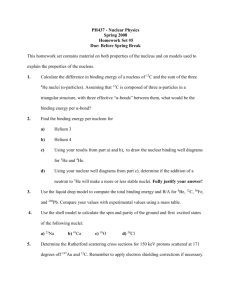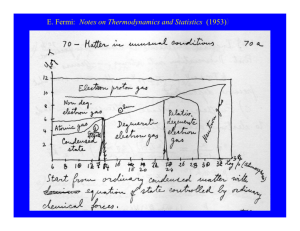Nuclear Masses 1

€
Binding
m ( N , Z ) = c
1
2
E ( N , Z ) = NM n
+ ZM
H
−
c
1
2
B ( N , Z )
The binding energy contributes significantly (~1%) to the mass of a nucleus. This implies that the constituents of two (or more) nuclei can be rearranged to yield a different and perhaps greater binding energy and thus points towards the existence of nuclear reactions in close analogy with chemical reactions amongst atoms.
B is positive for a bound system!
€
€
Nuclear liquid drop
The semi-empirical mass formula, based on the liquid drop model , considers five contributions to the binding energy (Bethe-Weizacker 1935/36)
B = a vol
A − a surf
A
2/ 3
15.68 18.56
− a sym
( N − Z ) 2
A
28.1
Z 2
− a
C
A
1/ 3
0.717
−
δ
( A ) pairing term
δ ( A ) =
$
&
%
− 34 A − 3 / 4 for even - even
0 for even - odd
&
& 34 A − 3/ 4 for odd - odd
Leptodermous expansion
B. Grammaticos, Ann. Phys. (NY)
139, 1 (1982)
Odd-even effect
Separation energies
A = 21 isobaric chain one-nucleon separation energies two-nucleon separation energies
Using http://www.nndc.bnl.gov/chart/ find one- and two-nucleon separation energies of 8 He, 11 Li, 45 Fe, 141 Ho, and 208 Pb.
Discuss the result.
Odd-even effect
chemical potential
J. Phys. G 39 093101 (2012)
Pairing energy
Δ n
=
Δ p
=
B ( N + 1, Z ) + B ( N − 1, Z )
− B ( N , Z )
2
N -odd
B ( N , Z + 1) + B ( N , Z − 1)
− B ( N , Z )
2
Z -odd
A common phenomenon in mesoscopic systems!
Example: Cooper electron pairs in superconductors …
Find the relation between the neutron pairing gap and one-neutron separation energies. Using http://www.nndc.bnl.gov/chart/ plot neutron pairing gaps for Er ( Z =68) isotopes as a function of N.
The semi-empirical mass formula, based on the liquid drop model , compared to the data
American Journal of Physics -- June 1989 -- Volume 57, Issue 6, p. 552
€
€
€ proton drip line
# ∂ B
%
$ ∂ Z
&
(
'
N = const
= 0 isobars stability valley
# ∂ B
%
$ ∂ N
&
(
'
A = const
= 0 isotones isotopes neutron drip line
# ∂ B
%
$ ∂ N
&
(
'
Z = const
= 0
€
€
€
Neutron star, a bold explanation
A lone neutron star, as seen by
NASA's Hubble
Space Telescope
B = a vol
A − a surf
A
2/ 3
− a sym
( N − Z )
A
2
− a
C
Z 2
A
1/ 3
− δ ( A ) +
3
5
G r
0
A
1/ 3
M
2
Let us consider a giant neutron-rich nucleus. We neglect Coulomb, surface, and pairing energies. Can such an object exist?
B = a vol
A − a sym
A +
3
5
G r
0
A
1/ 3
( m n
A )
2
= 0 limiting condition
3
5
G r
0 m n
2 A 2/3
= 7.5MeV
⇒ A ≅ 5 × 10 55 , R ≅ 4.3 km, M ≅ 0.045
M
⊙
More precise calculations give M(min) of about 0.1 solar mass (M
⊙ stars have
). Must neutron
R ≅ 10 km, M ≅ 1.4
M
⊙
Binding (summary)
• For most nuclei, the binding energy per nucleon is about 8MeV.
• Binding is less for light nuclei (these are mostly surface) but there are peaks for A in multiples of 4. (But note that the peak for 8 Be is slightly lower than that for 4 He.
• The most stable nuclei are in the A~60 mass region
• Light nuclei can gain binding energy per nucleon by fusing; heavy nuclei by fission.
• The decrease in binding energy per nucleon for A >60 can be ascribed to the repulsion between the (charged) protons in the nucleus: the
Coulomb energy grows in proportion to the number of possible pairs of protons in the nucleus Z(Z-1)/2
• The binding energy for massive nuclei ( A >60) grows roughly as A ; if the nuclear force were long range, one would expect a variation in proportion to the number of possible pairs of nucleons, i.e. as A(A-1)/2.
The variation as A suggests that the force is saturated ; the effect of the interaction is only felt in a neighborhood of the nucleon. http://amdc.in2p3.fr/web/masseval.html








